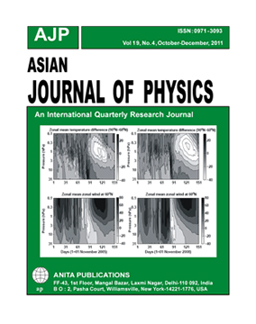
ap

ap
An International Peer Reviewed Research Journal

AJP
SSN : 0971 - 3093
Vol 22, No. 3 , July-September , 2013
Asian Journal of
Physics
Vol. 22, No. 3 (2013) 201-230
Spectra and structure of benzonitriles and some of its simple derivatives
M Alcolea Palafox1 and V K Rastogi2
1Departamento de Química-Física-I, Facultad C Químicas UCM, Madrid-28040, Spain
2R D Foundation Group of College, NH-58, Kadrabad, Modinagar (Ghaziabad), India
___________________________________________________________________________________________________________________
Dedicated to Professor KPR Nair
This
chapter shows a short compendium of the structure and spectra of
Benzonitrile and some of its simple mono- and di-substituted
derivatives, with special attention on those with important
properties. The importance and main applications of these molecules
are also briefly indicated. The geometry and vibrational
wavenumbers are analyzed. Several correlations with the structure
and spectral parameters are exposed.
Keywords: Benzonitrile, benzonitrile derivatives, molecular structure, vibrational wavenumbers,ab initio methods.
Total Refs: 171
____________________________________________________________________________________________________________________________________
Asian Journal of Physics Vol. 22, No. 3 (2013) 231-248
Photoacoustic spectroscopy of chemical vapours and atmospheric pollutants
Surya N Thakur
Ex-Professor of Physics, Banaras Hindu University, Varanasi-221 005, India
____________________________________________________________________________________________________________________________________
Dedicated to Professor KPR Nair
The review article starts with the basic principles of photoacoustic spectroscopy and describes in detail the methods of recording spectra using a microphone, a quartz tuning fork and a probe laser. The latest developments in this field using quantum cascade laser sources and very compact photoacoustic cells used by leading researchers have been described. Examples of trace gas detection include atmospheric pollutants and aerosols; horticultural damaging gases and medically important molecules.
Total Refs: 48
___________________________________________________________________________________________________________________
Asian Journal of Physics Vol. 22, No. 3 (2013) 249-258
Quantum fluctuations of the radiation field and wave particle duality
H Konwar1 and G D Baruah1, 2
1Department of Physics, Dibrugarh University, Dibrugarh-786 004 (India)
1, 2Center for Laser and Optical Science, New Uchamati, Doom-Dooma-786 151 (India)
____________________________________________________________________________________________________________________________________
Dedicated to Professor KPR Nair
Zero point fluctuation or vacuum fluctuation is the straightforward consequence of quantized radiation field. All quantized fields have fluctuations even in the vacuum state. Vacuum is not a tranquil state of nothingness, but rather a quantum state with fluctuations called vacuum fluctuations endowed with physical consequences. Vacuum fluctuations hold the key to understanding several processes including Lamb shift, spontaneous emission, Casimir effect and laser line width.In the present work we have worked out a method which indicates that the wave particle duality is the inherent nature of quantum fluctuation of the radiation field.
Keywords: Vacuum fluctuations, zero point energy, quantized field, wave particle duality, number state, vacuum state.
Total Refs: 36
____________________________________________________________________________________________________________________________________
Asian Journal of
Physics
Vol. 22, No. 3 (2013) 259-262
Multiconfiguration Hartree-Fock calculations in the sodium sequence
S N Tiwary
University Department of Physics, BRA Bihar University, Muzaffarpur, (Bihar), India
____________________________________________________________________________________________________________________________________
Dedicated to Professor KPR Nair
Excitation energies (∆E) and optical oscillator strengths (OOS), of both length ( fL) and velocity ( fV) forms, have been calculated for the inner-shell excitation 1s2 2s2 2p6 3s 2Se → 1s2 2s2 2p5 3s22Po transition, which leads to auto ionization (Auger transition), in Mg+, Al2+, Si3+, P4+, S5+, Cl6+, Ar7+ and K8+ ions of the sodium isoelectronic sequence by employing multi configuration Hartree-Fock (MCHF) method exactly in the same way as we did in our earlier work (Tiwary et al, Pramana-J. Phys. 46, 381 (1996); Kumar, Tiwary and Ray, Pramana-J. Phys. 76, 1 (2011)). Comparison has been made with our earlier theoretical results obtained by using the Hartree-Fock (HF) and the configuration interaction (CI) methods (Tiwary et al, Fizika 23, 27(1991)). Our present MCHF result is encouraging. © Anita Publications. All rights are reserved.
Keywords: Ions, Excitation energies; Oscillator strengths; MCHF.PACS No.: 31.20
Total Refs : 24
____________________________________________________________________________________________________________________________________
Asian Journal of Physics Vol. 22, No. 3 (2013) 263-270
Optical properties of sodium salicylate as a wavelength shifter under the effect of synchrotron radiation
Vijay
Kumara, B N Raja Sekharb*, V N Raic, Param
Jeet Singhb, V Sivasubramani d and, S K
Debc and B N Jagatapb
aIndus Operation & Accelerator Physics Design Division, RRCAT, Indore-452 013, India
bAtomic and Molecular Physics Division, BARC, Trombay, Mumbai-400 085, India
cIndus Synchrotron Utilization Division, RRCAT, Indore-452 013, India
dMaterial Science Division, IGCAR-Kalpakkam-603 102, India
____________________________________________________________________________________________________________________________________
Dedicated to Professor KPR Nair
Optical properties of sodium salicylate coating used as wavelength shifter in photophysics beamline at Indus-1 are presented. The absorption as well as photoluminescence of the coating decrease under the effect VUV irradiation and aging. Irradiation as well as aging produces different types of structural changes in the coating. VUV irradiation induces photochemical reaction resulting in some other compound and/or some defects, which drastically changes optical and structural properties of the coatings.
Keywords: Vacuum ultraviolet detector, Wavelength shifter, Absorption and photoluminescence,UV-Visible spectroscopy, Infrared and Raman spectroscopy
PACS: 41.60.Ap, 42.70.–a, 61.72.–y, 61.80.–x, 78.20.–e
Total Refs: 24
____________________________________________________________________________________________________________________________________
Asian Journal of
Physics
Vol. 22, No. 3 (2013) 271-276
Polarizability, hyperpolarizability, optical gap and hardness of halogenated aniline derivatives – A comparative study using conventional and long-range corrected hybrid functional
V Balachandrana*, K Anithab and M Karunanidhic
aCentre for Research, Department of Physics, A A Government Arts College, Musiri, Tiruchirapalli-621 201, India
bDepartment of Physics, Bharathidasan University Constituent College Lalgudi, Tiruchirapalli-621 601, India
cDepartment of Physics, Srimad Andavan Arts & Science College, Tiruchirapalli-620 005, India
____________________________________________________________________________________________________________________________________
Dedicated to Professor KPR Nair
Calculations
at Hatree-Fock(HF), Density Functional Theory (DFT) and Long range
Correction (LC-DFT) functional were carried out with 6-311++G(d,p)
basis set for estimate the dipole moment (µ), the static
polarizability (α), second hyperpolarizability (β), optical
gap (∆H-L) and chemical hardness (η) of halogenated
aniline derivatives. Variations in optical gap and first
hyperpolarizability which are measures of non-linear optical
parameters are also computed. Our results show that DFT
schemes overestimate a values relative to LC-DFT ones. The average
dipole moment (µ), the static polarizability (α),
second hyperpolarizability (β), optical gap
(∆H-L) and chemical hardness (η) of halogenated aniline
derivatives show their optimum value for 2-bromoaniline,
2-chloroaniline, and 2-fluoroaniline derivatives. The maximum
polarizability and minimum chemical hardness are due to greater
extents of charge transfer which arise from smaller optical gap.
The study reveals that the halogenated aniline based molecules are
promising candidates for applications in non-linear
optics.
Keywords: Hyperpolarizability, Optical gap, Long range correction, Aniline derivatives.
Total Refs : 22
____________________________________________________________________________________________________________________________________
Asian Journal of
Physics
Vol. 22, No. 3 (2013) 277-290
FT-IR and FT-Raman spectral analysis and quantum chemical
studies on 4-aminobenzoic acid
and 4-cyanobenzoic acid
V Arjunan1*, R Remya2, L Devi2, S Senthikumari1 and S Mohan3
1Department of Chemistry, Kanchi Mamunivar Centre for Post-Graduate Studies, Puducherry-605 008. India
2Research and Development Centre, Bharathiar University, Coimbatore 641 046, India
3School of Sciences and Humanities, Vel Tech University, Avadi, Chennai-600 032
____________________________________________________________________________________________________________________________________ Dedicated to Professor KPR Nair
The FT-IR and FT-Raman spectra of 4-aminobenzoic acid (4ABA) and 4-cyanobenzoic acid (4CBA) have been recorded in the range 4000-400 and 4000-100 cm–1, respectively. The complete vibrational assignment and analysis of the fundamental modes of the compounds were carried out using the observed FTIR and FT-Raman data. The vibrational frequencies determined experimentally were compared with those obtained theoretically from ab initio HF and DFT-B3LYP gradient calculations employing 6-31G**, 6-311++G** and cc-PVTZ basis sets for the optimised geometries of the compounds. The normal coordinate analysis was also carried out by Wilson’s FG matrix method. The interactions of the skeletal vibrational modes are investigated.© Anita Publications.
Keywords: 4-aminobenzoic acid, 4-cyanobenzoic acid, DFT, FTIR, FT-Raman.
Total Refs : 53
____________________________________________________________________________________________________________________________________
Asian Journal of Physics Vol. 22, No. 3 (2013) 291-304
Spectroscopic and DFT studies of 2,
3-dihydro-4-methylthiophene-1, 1-dioxide
and 2,3-dihydrothiophene-1, 1-dioxide
V Arjunan1*, R Remya2, R Anitha1, Arushma Raj1 and S Mohan3
1Department of Chemistry, Kanchi Mamunivar Centre for Post-Graduate Studies, Puducherry-605 008, India
2Research and Development Centre, Bharathiar University, Coimbatore-641 046, India
3School Sciences and Humanities, Vel Tech University, Chennai-600 062, India
____________________________________________________________________________________________________________________________________
Dedicated to Professor KPR Nair
Spectroscopic
studies and theoretical quantum chemical calculations of
2,3-dihydro-4-methylthiophene-1,1-dioxide (DHMT) and
2,3-dihydrothiophene-1,1-dioxide (DHT) have been carried out by
using B3LYP methods, FTIR and FT-Raman spectral techniques. The
geometry of the compounds have been optimized by B3LYP method with
6–311++G** and cc–pVTZ basis sets. The geometrical parameters
obtained at B3LYP levels have been compared with the experimental
values. Molecular electrostatic potential surface, total electron
density distribution and frontier molecular orbitals are
constructed at B3LYP/cc–pVTZ level to understand the electronic
properties. The charge density distribution and site of chemical
reactivity of the molecules have been obtained by mapping electron
density isosurface with electrostatic potential surfaces. The HOMO
and LUMO energies and their energy gap are
measured.
Keywords: 2, 3-dihydro-4-methylthiophene-1,1-dioxide, 2, 3-dihydrothiophene-1, 1-dioxide, B3LYP, FTIR, FT-Raman.
Total Refs : 35
____________________________________________________________________________________________________________________________________
Asian Journal of
Physics
Vol. 22, No. 3 (2013) 305-312
DFT and vibrational spectroscopic study on glycinium
succinimide NLO active material
D Arul Dhasa, I Hubert Joeb, S D D Roya and S Balachandranc
aDepartment of Physics, Nesamony Memorial Christian College, Marthandam-629 165, TamilNadu India
bCentre for Molecular and Biophysics Research, Department of Physics, Mar Ivanios College, Thiruvananthapuram-695 015, Kerala, India
cDepartment of Chemistry, M G College, Thiruvananthapuram-695 004, Kerala, India
____________________________________________________________________________________________________________________________________
Dedicated to Professor KPR Nair
Vibrational
spectral analysis of glycinium succinimide have been carried out
using NIR FT-Raman and FTIR spectroscopic techniques. The FTIR and
FT-Raman spectra have been recorded in the region 400–4000
cm-1 and 50-3500 cm-1 respectively. The
geometry has been optimized with complete relaxation on the
potential energy surface at B3LYP level of theories using 6-311G
(df, p) basis set using Gaussian 09 program and compared with the
crystal data. Further harmonic vibrational frequency calculations
have been carried out at B3LYP levels and the scaled values were in
good agreement with majority of the experimental observations. The
NBO and structural analysis have been performed. Theoretical
methods have been used to study the proper and improper hydrogen
bonds, considering the hydrogen bond length and charge transfer.
The calculated geometrical parameters also show a very strong
hydrogen bond. The first order hyperpolariz and charge transfer
analysis shows the NLO active nature of the experimental
compound.
Keywords: DFT, Hydrogen bonding, NLO activity, NBO analysis, FTIR, FT-RAMAN.
_______________________________________________________________________________________________________
© ANITA PUBLICATIONS
All rights reserved
Designed & Maintained by
Manoj
Kumar